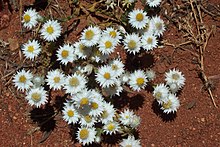
Pterocaulon sphacelatum, commonly known as apple bush or fruit-salad plant, is a species of flowering plant in the family Asteraceae. It is an upright shrub with mostly pink to purple flowers and is endemic to Australia.

Olearia floribunda, commonly known as heath daisy-bush, is a species of flowering plant in the family Asteraceae and is endemic to south-eastern Australia. It is an upright, spreading shrub with egg-shaped leaves and white and yellow or mauve, daisy-like inflorescences.
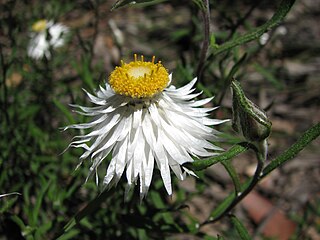
Helichrysum leucopsideum, commonly known as satin everlasting, is a flowering, perennial herb in the family Asteraceae. It is grows in all states of Australia except Queensland and the Northern Territory. It has white, terminal flower heads and narrow, woolly leaves.
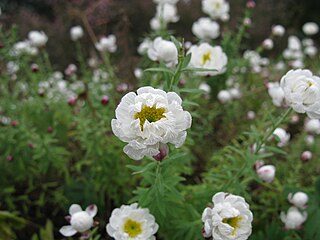
Rhodanthe anthemoides, commonly known as chamomile sunray, is a flowering plant in the family Asteraceae. It is a small, perennial shrub with greyish-green leaves, white papery flowers, yellow centre and is endemic to Australia.
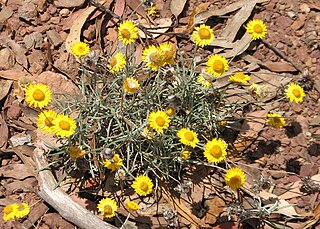
Leucochrysum albicans, commonly known as hoary sunray, is a flowering plant in the family Asteraceae. It is a small perennial with grey leaves, white or yellow flower-heads and is endemic to Australia.

Rhodanthe manglesii is a herbaceous plant, a native of Western Australia, that was introduced and cultivated in England in 1834 from seeds collected by James Mangles. Common names for this daisy include pink sunray, silver bells, Australian strawflower, timeless rose or Mangles everlasting.

Leionema diosmeum is a shrub species in the family Rutaceae that is endemic to southern New South Wales, Australia. It has an upright habit, stems with fine soft hairs, variable shaped leaves and yellow flowers from late winter to spring.

Nematolepis ovatifolia, is a small shrub with rusty coloured scales on the stems, smooth, glossy leaves and white flowers in small clusters in summer. It is endemic to New South Wales.

Schoenia filifolia is a species of flowering plant in the family Asteraceae, and is endemic to the southwest of Western Australia. It is an annual herb with terete leaves and yellow, daisy-like inflorescences.

Coronidium rupicola, commonly known as the yellow button, is a flowering plant in the family Asteraceae. It is a small, upright, perennial shrub with yellow flowers borne on a single stem and is endemic to Queensland, Australia.

Brachyscome spathulata, commonly known as spoon-leaved daisy, is a flowering plant in the family Asteraceae. It has dark green leaves, mauve daisy-like flowers and grows in New South Wales, Tasmania, Victoria and the Australian Capital Territory.

Argentipallium obtusifolium, commonly known as blunt everlasting, is a species of flowering plant in the family Asteraceae. It is a small, multi-stemmed perennial with white flowers, dark green leaves and is endemic to Australia.

Rhodanthe chlorocephala commonly known as pink and white everlasting, is a flowering plant in the family Asteraceae. It is a small, tufted plant with blue-green leaves, white, pink or yellow flowers and grows in Western Australia and South Australia.

Rhodanthe humboltiana, commonly known as the golden cluster everlasting, is a flowering annual in the family Asteraceae. It is a small, upright, branching plant with yellow flowers, and is endemic to Western Australia.
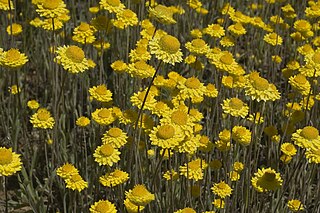
Leucochrysum molle, commonly known as hoary sunray, is a flowering plant in the family Asteraceae. It is a small, clumping perennial with grey leaves, yellow flower-heads and is endemic to Australia.

Hyalosperma praecox commonly known as fine-leaf sunray, is a flowering plant in the family Asteraceae. It is an upright, annual herb with stems branching from the base and yellow or white flowers and grows in New South Wales and Victoria.

Hyalosperma demissum, commonly known as moss sunray, is a flowering plant in the family Asteraceae. It is a small, annual herb with whitish yellow flowers and is endemic to Australia.

Podolepis hieracioides commonly known as long podolepis, is a flowering plant in the family Asteraceae and grows in New South Wales and Victoria. It is a small perennial with yellow flowers.

Hyalosperma simplex is a flowering plant in the family Asteraceae. It is an upright, annual herb with stems branching from the base and yellow or white flowers and is endemic to Western Australia.

Leucochrysum alpinum, commonly known as alpine sunray, is a flowering plant in the family Asteraceae. It is a small, clumping perennial with grey leaves, white flower-heads and is endemic to Australia.
